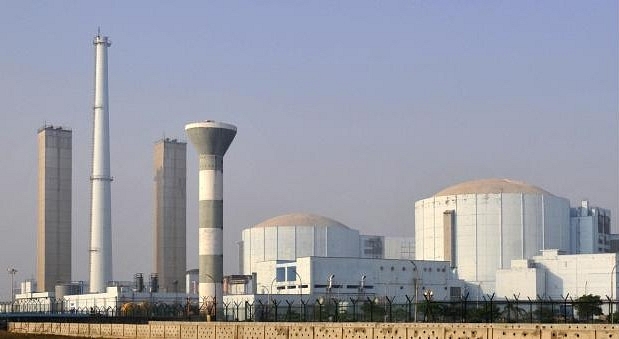
Explained: Why India Is Betting Big On Heavy Water Reactors
Signaling its intent to fast-track India’s domestic nuclear power programme, the government on Wednesday approved a proposal to construct 10 indigenous units of pressurised heavy water reactors (PHWRs), each with the capacity of generating 700 Mega Watt (MW) of electricity, in a fully home grown initiative.
This takes the number of planned 700MW PHWRs in India to 14, four of which are currently under construction at Kakrapar Atomic Power Station in Gujarat and Rajasthan Atomic Power Station in Rajasthan. Currently, India has 12 operational PHWRs with significantly lower capacities of 100 MW, 200 MW, 220 MW and 540 MW. The PHWR in Kakrapar, which is expected to go in for trial runs in June, will potentially be India’s first 700MW PHWR to be commissioned.
PHWRs were initially developed in Canada with the experience it gained working with wartime allied countries in the 1940s and was known as CANDU. In 1956, it supplied a 40 MW CANDU reactor to India, heavy water for which was supplied by the United States (US). It was, allegedly, plutonium derived from the spent fuel of this reactor that India used to detonate its first nuclear device at Pokhran, Rajasthan in 1974.
How Are PHWRs Different From Light Water Reactors?
PHWRs reactors use heavy water as a neutron moderator and coolant and natural uranium as fuel, unlike Light Water Reactors (LWRs) which use uranium enriched up to 3 to 5 per cent as fuel and normal water as both its coolant and neutron moderator. Another major difference between the two is that a PHWRs produce more plutonium and tritium as a by-product compared to LWRs. Also, PHWRs do not need to be shut down for refuelling while LWRs are refuelled after shutdown.
Why Does India Choose Heavy Water Reactors?
India’s nuclear power program is currently based mainly on a series of PHWRs, some of which have been separated from reactors meant to feed the country’s nuclear weapons programme and placed under safeguards of the International Atomic Energy Agency (IAEA). PHWRs have been chosen because of availability of fuel, indigenous technology and expertise, resources and the need for power generation infrastructure.
A PHWR uses unenriched natural uranium as its fuel, unlike LWRs. Having placed most its PHWRs under safeguards, Indian has made sure that it can use imported fuel in these facilities. In the most likely scenario, India will place some of the new PHWRs it is constructing under IAEA safeguards, ensuring continuous supply of fuel for them.
The use of PHWRs also brings other advantages. Because these reactors use natural uranium as fuel, they can be operated without constructing expensive facilities that are required to enrich uranium. The PHWRs are also more efficient than comparable LWR as they produce more energy per kilogram of mined uranium. These advantages make PHWRs ideal for India’s nuclear energy programme.
Opponents of PHWRs cite the high cost of heavy water as a drawback. But in view of the aforementioned fact that PHWRs produce more energy per kilogram of mined uranium as compared to LWR, the high cost of the heavy water can bee seen as a trade-off against reduced fuel costs.
Another important point that influences government’s choice is the presence of indigenous technology and expertise. The first two PHWRs were built in Rajasthan with Canadian collaboration and became operational in the year 1973 and 1981. Since then, India has invested in development of this design in a sustained manner, developing lower capacities of 100 MW, 200 MW, 220 MW and 540 MW before moving to 700 MW.
The choice also marks a response to the near collapse of Westinghouse, the US-based reactor maker that was set to sign a deal with India for the construction of six of its AP1000 reactors a single site in southeastern India. The firm, owned by Japan's Toshiba, filed for bankruptcy in March, raising doubts about whether it can complete the India deal. GE-Hitachi and France's state-owned Areva were also expected to build nuclear reactors in India, but financial troubles surrounding these reactor makers have further dimmed the prospects of international cooperation.
Therefore, switching to indigenous technology was the only reliable way forward.
However, this is the first time that the government has cleared the construction of 10 nuclear reactors in one go. With another four already under construction, why does India need 10 new nuclear reactors?
Why India needs more nuclear reactors?
Of India’s total power generation capacity of 326,848.53MW, two-thirds, that is nearly 217,492.26 MW, is fuelled by coal. Renewable energy accounts for 57,260.23 MW. Nuclear energy accounts for only 6,780 MW, that is 2.07 per cent of total capacity. Therefore, as India moves towards cleaner sources of energy, nuclear power plants can replace plants fuelled by coal and other polluting fuels.
Moreover, India has committed, under the Paris climate change accord, that by 2030, at least 40 per cent of its electricity will be generated from non-fossil sources. To replace coal using thermal plants with nuclear power plants, as France has done, India needs to construct these in large numbers. India’s plan to ramp up nuclear output to 32,000 MW by 2032 can contribute significantly.
But clean energy, although the most important driver, is not the only reason. Well over 300 million Indians live without electricity when the country’s per capita electricity consumption has reached 1010 kilowatt-hour (kWh). The per capita consumption in 2013-14 was 957 kWh in 2013-14 and is expected to rise to 5300 units of power. To keep up with this growth in demand, India will have to construct a large number of nuclear power plants.